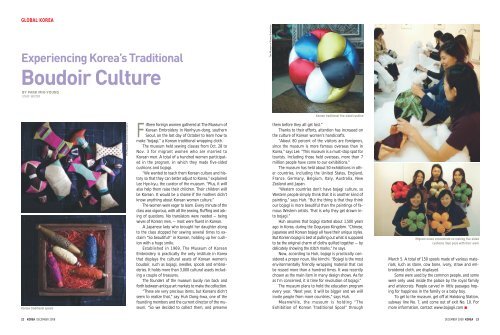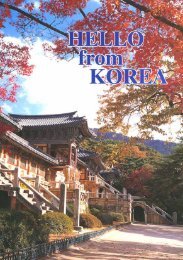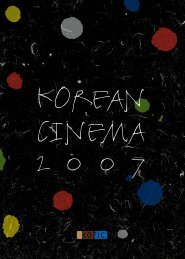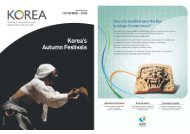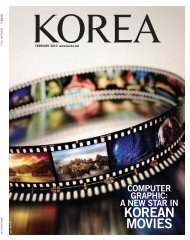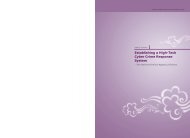Seoul Lights Up for the Holiday Season - Korea.net
Seoul Lights Up for the Holiday Season - Korea.net
Seoul Lights Up for the Holiday Season - Korea.net
You also want an ePaper? Increase the reach of your titles
YUMPU automatically turns print PDFs into web optimized ePapers that Google loves.
GLOBAL KOREA<br />
Experiencing <strong>Korea</strong>’s Traditional<br />
Boudoir Culture<br />
The Museum of <strong>Korea</strong>n Embroidery<br />
BY PARK MIN-YOUNG<br />
STAFF WRITER<br />
<strong>Korea</strong>n traditional five-sided cushion<br />
<strong>Korea</strong>n traditional spools<br />
The Museum of <strong>Korea</strong>n Embroidery<br />
Fifteen <strong>for</strong>eign women ga<strong>the</strong>red at The Museum of<br />
<strong>Korea</strong>n Embroidery in Nonhyun-dong, sou<strong>the</strong>rn<br />
<strong>Seoul</strong>, on <strong>the</strong> last day of October to learn how to<br />
make “bojagi,” a <strong>Korea</strong>n traditional wrapping cloth.<br />
The museum held sewing classes from Oct. 28 to<br />
Nov. 3 <strong>for</strong> migrant women who are married to<br />
<strong>Korea</strong>n men. A total of a hundred women participated<br />
in <strong>the</strong> program, in which <strong>the</strong>y made five-sided<br />
cushions and bojagi.<br />
“We wanted to teach <strong>the</strong>m <strong>Korea</strong>n culture and history<br />
so that <strong>the</strong>y can better adjust to <strong>Korea</strong>,” explained<br />
Lee Hye-kyu, <strong>the</strong> curator of <strong>the</strong> museum. “Plus, it will<br />
also help <strong>the</strong>m raise <strong>the</strong>ir children. Their children will<br />
be <strong>Korea</strong>n. It would be a shame if <strong>the</strong> mo<strong>the</strong>rs didn’t<br />
know anything about <strong>Korea</strong>n women culture.”<br />
The women were eager to learn. Every minute of <strong>the</strong><br />
class was vigorous, with all <strong>the</strong> sewing, fluffing and asking<br />
of questions. No translators were needed — being<br />
wives of <strong>Korea</strong>n men, — most were fluent in <strong>Korea</strong>n.<br />
A Japanese lady who brought her daughter along<br />
to <strong>the</strong> class stopped her sewing several times to exclaim<br />
“So beautiful!” in <strong>Korea</strong>n, holding up her cushion<br />
with a huge smile.<br />
Established in 1969, The Museum of <strong>Korea</strong>n<br />
Embroidery is practically <strong>the</strong> only institute in <strong>Korea</strong><br />
that displays <strong>the</strong> cultural assets of <strong>Korea</strong>n women’s<br />
boudoir, such as bojagi, needles, spools and embroideries.<br />
It holds more than 3,000 cultural assets including<br />
a couple of treasures.<br />
The founders of <strong>the</strong> museum busily ran back and<br />
<strong>for</strong>th between antique art markets to make <strong>the</strong> collection.<br />
“These are very precious items, but <strong>Korea</strong>ns didn’t<br />
seem to realize that,” say Huh Dong-hwa, one of <strong>the</strong><br />
founding members and <strong>the</strong> current director of <strong>the</strong> museum.<br />
“So we decided to collect <strong>the</strong>m, and preserve<br />
<strong>the</strong>m be<strong>for</strong>e <strong>the</strong>y all get lost.”<br />
Thanks to <strong>the</strong>ir ef<strong>for</strong>ts, attention has increased on<br />
<strong>the</strong> culture of <strong>Korea</strong>n women’s handicrafts.<br />
“About 80 percent of <strong>the</strong> visitors are <strong>for</strong>eigners,<br />
since <strong>the</strong> museum is more famous overseas than in<br />
<strong>Korea</strong>,” says Lee. “This museum is a must-stop spot <strong>for</strong><br />
tourists. Including those held overseas, more than 7<br />
million people have come to our exhibitions.”<br />
The museum has held about 50 exhibitions in o<strong>the</strong>r<br />
countries, including <strong>the</strong> United States, England,<br />
France, Germany, Belgium, Italy, Australia, New<br />
Zealand and Japan.<br />
“Western countries don’t have bojagi culture, so<br />
Western people simply think that it is ano<strong>the</strong>r kind of<br />
painting,” says Huh. “But <strong>the</strong> thing is that <strong>the</strong>y think<br />
our bojagi is more beautiful than <strong>the</strong> paintings of famous<br />
Western artists. That is why <strong>the</strong>y get drawn into<br />
bojagi.”<br />
Huh assumes that bojagi started about 1,500 years<br />
ago in <strong>Korea</strong>, during <strong>the</strong> Goguryeo Kingdom. “Chinese,<br />
Japanese and <strong>Korea</strong>n bojagi all have <strong>the</strong>ir unique styles.<br />
But <strong>Korea</strong>n bojagi is best at pulling out what is supposed<br />
to be <strong>the</strong> original charm of cloths quilted toge<strong>the</strong>r — by<br />
delicately showing <strong>the</strong> stitch marks,” he says.<br />
Now, according to Huh, bojagi is practically considered<br />
a proper noun, like kimchi. “Bojagi is <strong>the</strong> most<br />
environmentally friendly wrapping material that can<br />
be reused more than a hundred times. It was recently<br />
chosen as <strong>the</strong> main item in many design shows. As far<br />
as I’m concerned, it is time <strong>for</strong> revolution of bojagi.”<br />
The museum plans to hold <strong>the</strong> education program<br />
every year. “Next year, it will be bigger and we will<br />
invite people from more countries,” says Huh.<br />
Meanwhile, <strong>the</strong> museum is holding “The<br />
Exhibition of <strong>Korea</strong>n Traditional Spool” through<br />
Migrant wives concentrate on making five-sided<br />
cushions (top) pose with <strong>the</strong>ir work<br />
March 5. A total of 150 spools made of various materials,<br />
such as stone, cow bone, ivory, straw and embroidered<br />
cloth, are displayed.<br />
Some were used by <strong>the</strong> common people, and some<br />
were only used inside <strong>the</strong> palace by <strong>the</strong> royal family<br />
and aristocrats. People carved in little passages hoping<br />
<strong>for</strong> happiness in <strong>the</strong> family or a baby boy.<br />
To get to <strong>the</strong> museum, get off at Hakdong Station,<br />
subway line No. 7, and come out of exit No. 10. For<br />
more in<strong>for</strong>mation, contact www.bojagii.com ■<br />
22 KOREA DECEMBER 2008<br />
DECEMBER 2008 KOREA 23


